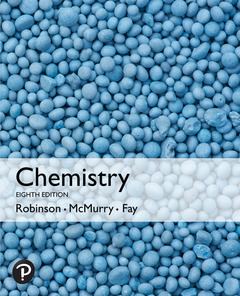Description
Chemistry, Global Edition (8th Ed.)
Authors: McMurry John, Fay Robert, Robinson Jill
Language: English
Subject for Chemistry, Global Edition:
86.89 €
In Print (Delivery period: 14 days).
Add to cart1200 p. · 22.9x27.4 cm · Paperback
Description
/li>Contents
/li>Biography
/li>Comment
/li>
Give students a robust conceptual foundation while building critical problem-solving skills
Robinson/McMurry/Fay?s Chemistry, known for a concise and united author voice, conceptual focus, extensive worked examples, and thoroughly constructed connections between organic, biological, and general chemistry, highlights the application of chemistry to students? lives and careers. Lead author Jill Robinson strengthens the student orientation by creating more engaging, active learning opportunities for students and faculty.
With the 8th Edition, Robinson draws upon her exceptional teaching skills to provide new interactive experiences that help identify and address students? preconceptions.
Samples
Download the detailed table of contents
- 1. Chemical Tools: Experimentation and Measurement
- 2. Atoms, Molecules, and Ions
- 3. Mass Relationships in Chemical Reactions
- 4. Reactions in Aqueous Solution
- 5. Periodicity and the Electronic Structure of Atoms
- 6. Ionic Compounds: Periodic Trends and Bonding Theory
- 7. Covalent Bonding and Electron-Dot Structures
- 8. Covalent Compounds: Bonding Theories and Molecular Structure
- 9. Thermochemistry: Chemical Energy
- 10. Gases: Their Properties and Behavior
- 11. Liquids and Phase Changes
- 12. Solids and Solid-State Materials
- 13. Solutions and Their Properties
- 14. Chemical Kinetics
- 15. Chemical Equilibrium
- 16. Aqueous Equilibria: Acids and Bases
- 17. Applications of Aqueous Equilibria
- 18. Thermodynamics: Entropy, Free Energy, and Spontaneity
- 19. Electrochemistry
- 20. Nuclear Chemistry
- 21. Transition Elements and Coordination Chemistry
- 22. The Main-Group Elements
- 23. Organic and Biological Chemistry
Jill K. Robinson received her Ph.D. in analytical and atmospheric chemistry from the University of Colorado at Boulder. She is a senior lecturer at Indiana University and teaches general, analytical, and environmental chemistry courses. Her clear and relatable teaching style has been honored with several awards including the President’s Award for Distinguished Teaching at Indiana University and the J. Calvin Giddings Award for Excellence in Education from the American Chemical Society Division of Analytical Chemistry. She leads workshops to help faculty transition from lecture-based instruction to student-centered pedagogies.
John McMurry, educated at Harvard and Columbia, has taught more than 20,000 students in general and organic chemistry over a 40-year period. An emeritus professor of chemistry at Cornell University, Dr. McMurry previously spent 13 years on the faculty at the University of California at Santa Cruz. He has received numerous awards, including the Alfred P. Sloan Fellowship (1969—71), the National Institute of Health Career Development Award (1975—80), the Alexander von Humboldt Senior Scientist Award (1986—87), and the Max Planck Research Award (1991).
Robert C. Fay, professor emeritus at Cornell University, taught general and inorganic chemistry at Cornell for 45 years beginning in 1962. Known for his clear, well-organized lectures, Dr. Fay was the 1980 recipient of the Clark Distinguished Teaching Award. He has also taught as a visiting professor at Harvard University and the University of Bologna (Italy). A Phi Beta Kappa graduate of Oberlin College, Dr. Fay received his Ph.D. from the University of Illinois. He has been an NSF Science Faculty Fellow at the University of East Anglia and the University of Sussex (England) and a NATO/Heineman Senior Fellow at Oxford University.
Facilitate active learning and engage students in learning chemistry
- Big Idea questions provide new interactivity within the eText and teach students how to actively read a science text by modeling the kinds of questions they should ask themselves, prompting them to summarize main points, and stimulating them to make connections between concepts and mathematical problems. These questions help ensure students are familiar with main concepts and terms before coming to class. Activities like this also improve retention and comprehension by asking students to answer questions at the end of reading a section for retrieval practice.
- Newly Interactive - Figure It Out questions provide new interactivity within the eText so students can test themselves at the point of learning and receive instant, answer-specific feedback written by author Jill Robinson. Questions appear with select figures and encourage students to look at each illustration more carefully and recognize general lessons offered in the figure.
- New - Practice Tests provide assessment for chapter learning objectives and additional instruction in concepts and problem-solving skills in the printed text as well as in the eText and Mastering Chemistry. When students miss a problem, they are instructed to consult the study guide for additional instruction and practice problems. When a student answers incorrectly in Pearson MasteringChemistry or the eText, their practice exam automatically links to worked examples and additional practice problems.
- Updated - Inquiry sections highlight the importance of chemistry, promote student interest, and deepen student understanding of the content by showcasing problems that revisit several chapter concepts. These problems can be covered in class, recitation sections, or assigned as homework in Mastering Chemistry.
Build problem-solving sk




